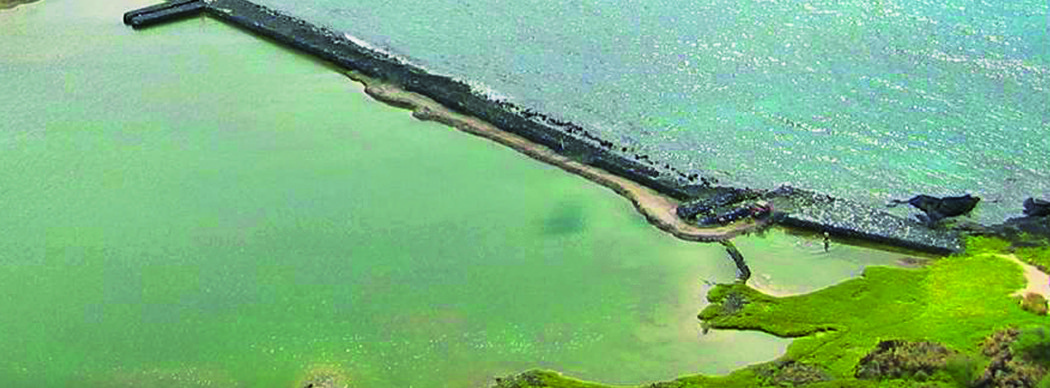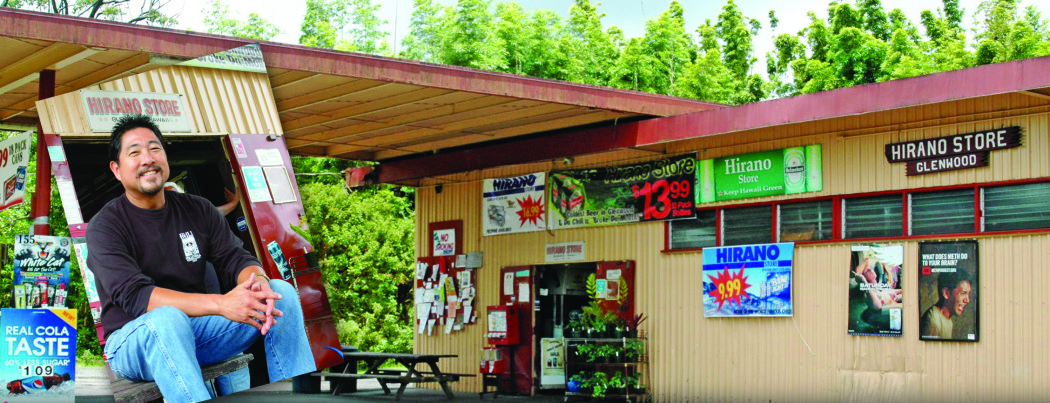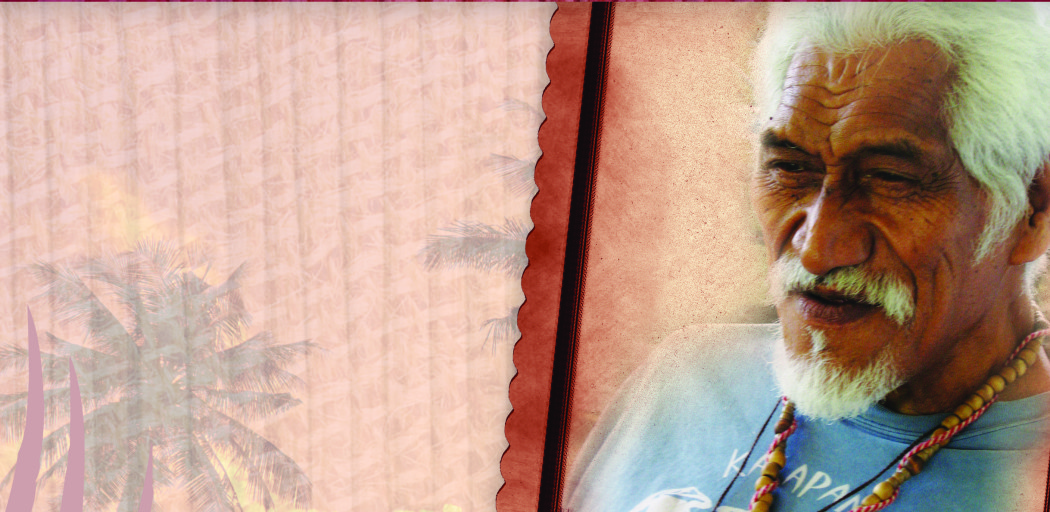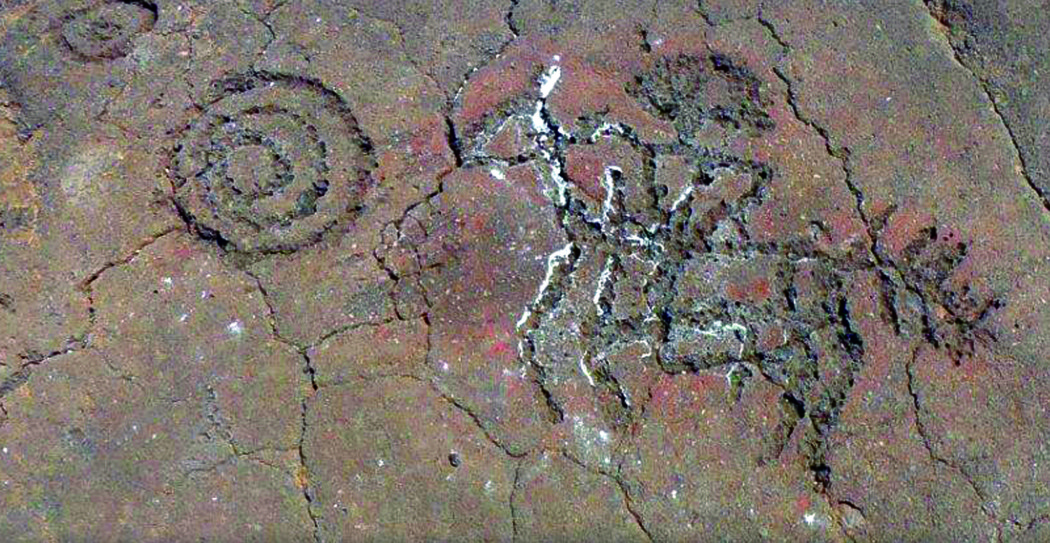
Then & Now: Kaloko Honokōhau National Historic Park
 The Last in a Series of Profiles on Hawai‘i Island’s National Parks
The Last in a Series of Profiles on Hawai‘i Island’s National Parks
by Robert Oaks
The Kaloko-Honokōhau National Historical Park, located south of the Kona airport, provides clues to the lifestyle of early Hawaiians. Atop seemingly barren and inhospitable lava flows, the park incorporates the shoreline portions of the ancient Kaloko, Honokōhau, and Kealakehe ahupua‘a.
An ahupua‘a was a section of land, often approximately triangular in shape, that stretched from the seashore up into the mountains. By providing different topographies, the land could provide a community of from 60 to 100 people with everything they needed for a self-sustaining economy: marine life on the coast and agricultural lands (and rainfall) on the higher elevations of Hualālai volcano.
Designated as a National Historic Landmark in 1962, the site attained full National Park status in 1978. Intended to demonstrate the settlement patterns and lifestyle of pre-contact Hawaiians, Kaloko-Honokōhau Park includes fish ponds, a fish trap, heiau (temple), house ruins, petroglyphs, burial sites, and a slide for the ancient Hawaiian sport of holua. Probably first settled around the year 1000 A.D., people lived on this land into the 19th century.
When the inhabitants left the area for more hospitable regions along the Kona Coast, they abandoned hundreds of significant archeological sites that were largely undisturbed in the 20th century. And because these sites were not destroyed by subsequent development, the park provides one of the best windows into many aspects of traditional Hawaiian culture and lifestyles.
The Kaloko and ‘Aimakapā Fishponds and the ‘Ai‘ōpio Fishtrap are the most significant archeological sites in the park because they are among the few surviving examples of these feats of Hawaiian engineering. At one time there were as many as nineteen fish ponds on the Kona coast, each a center of settlement and social life.
The 11-acre Kaloko Fishpond, at the northern end of the park, is the more important of the two. Kaloko simply means “the pond.” It consists of a natural bay that was cut off from the sea by a massive, manmade, stone seawall, at least 300 and possibly as much as 700 years old. Stretching for 250 yards, the wall is 30 to 40 feet wide and six-and-one-half feet tall. Built without mortar, it consists of an ingenious pile of interlocking rocks. Within the pond, smaller secondary walls were used to segregate different types of fish that were raised there. The importance of the pond is perhaps reflected in the naming of the ahupua‘a itself, Kaloko.
The area around this fishpond is also important as a burial site. Several high ranking ali‘i (chiefs) were buried here, and it is possible that the secret and still undiscovered burial site of King Kamehameha himself is nearby. As a result, the pond is extremely significant to the culture and history of Hawaiians, many of whom regard the site as sacred.
‘Aimakapā Fishpond to the south is somewhat larger than Kaloko. Rather than rock walls, the seawater in this pond was trapped behind sand dunes. Currently it is about 15 acres, though it was once probably twice that size. Originally a stone-lined channel cut through the dunes, providing a sluice gate through which seawater entered the pond. There are still fish in this pond, though the water is brackish, and it has become a major wildlife bird refuge.
Nearby, a holua slide is one of only eight that survive in Kona. The narrow track, constructed of stone, was covered with grass to produce a slick surface. Two contestants could compete at the same time. A contestant, who had to be from the ali‘i class, would lie on a narrow wooden sled and attempt to ride it all the way to the bottom, similar to tobogganing, though of course on dry land.
At the southern end of the park, next to Honokōhau Harbor, is the ‘Ai‘ōpio Fishtrap. About two acres in size, the trap is separated from the ocean by a manmade, stone wall. Unlike the fishponds, which were used primarily to raise fish, the trap, as the name implies, was built to catch fish.
At high tide, fish could enter through a narrow channel in the wall. They could then be caught with nets or simply trapped when the tide receded. Four walled enclosures along the shore were probably holding pens. The trapped fish possibly were transferred to the nearby ‘Aimakapā Fishpond.
Near the fishtrap is Pu‘u‘oina Heiau, sometimes called Hale o Manō. The 50-by-145-foot stone structure is a fine example of the platform style of heiau. A small pool just to the north of the structure may have been used for ceremonial purposes. A large burial platform is also north of the heiau. Its location near the ‘Ai‘ōpio Fishtrap suggests that the heiau was an important site for governing a large area of north Kona and overseeing the crucial fishing activities of the region.
In addition to the archeological attractions of Kaloko-Honokōhau, the park is also home to many varieties of birds and plants, as well as the green sea turtle (honu). The fishponds and fishtrap, originally built to supply food for Hawaiians, now provide a source of food for many wetland birds. Nearly 50 types of birds are unique to Hawai‘i, although many of them are endangered by the introduction of a larger number of alien birds, which compete for food and nesting spots as well as spread diseases and parasites unknown to the native varieties. The park tries to protect the native species, providing the visitor with an opportunity for bird watching.
Similarly, more than 130 green sea turtles live in the waters offshore and often sun themselves on the narrow, sandy beach. These turtles were listed as an endangered species in the same year that Kaloko-Honokōhau became a National Park. The protection they receive may account for their relatively recent sun basking habit, apparently unafraid of human visitors engaged in the same activity.
The Park Service also attempts to protect native plants. Non-native, invasive species have been cleared from Kaloko fishpond, allowing the native pili grass, which Hawaiians used for thatching, to flourish again. This is an ongoing struggle, however, since there are still threats from non-native algae and fish in the ponds, as well as mongooses, which eat nesting birds and their eggs. ❖
Contact writer Robert Oaks: boboaks@pacbell.net
BIBLIOGRAPHY
Cordy, Ross. Exalted Sits the Chief: The Ancient History of Hawai‘i Island. Honolulu: Mutual Publishing, 2000.
Greene, Linda Wedel. “A Cultural History of Three Traditional Hawaiian Sites on the West Coast of Hawai’i Island.” http://www.cr.nps.gov/history/online_books/kona/history.htm. National Park Service, 1993.
Kirch, Patrick Vinton. Feathered Gods and Fishhooks, An Introduction to Hawaiian Archaeology and Prehistory. Honolulu: University of Hawai‘i Press, 1985.
National Park Service, “Kaloko-Honokōhau National Historical Park”, http://www.nps.gov/kaho
Oaks, Robert F. Hawai‘i, A History of the Big Island. Charleston, S.C.: Arcadia Publishing, 2003.


